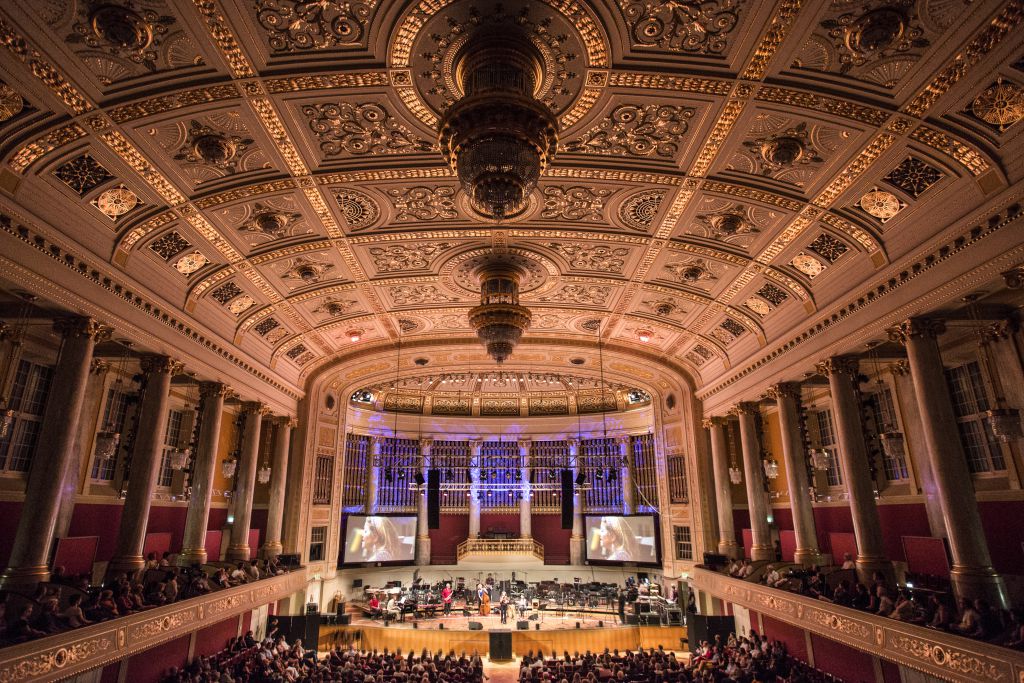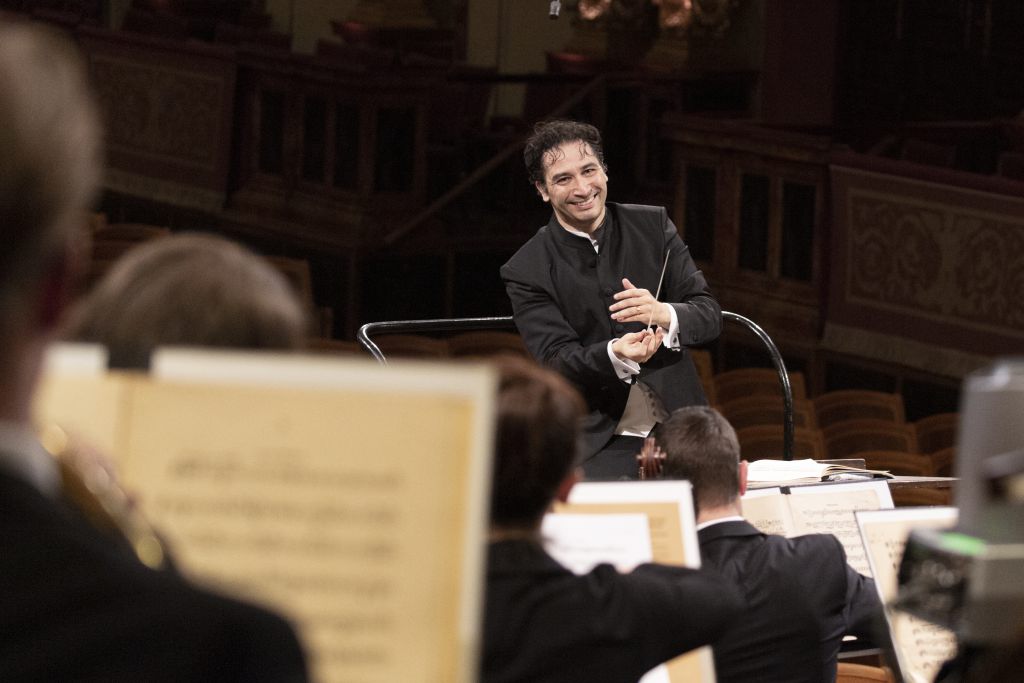The transdisciplinary project KlangBildKlang mediates between visual and musical experiences.
“[…]And the whole […] stands almost finished and complete in my mind, so that I can survey it, like a fine picture or a beautiful statue, at a glance.” When Wolfgang Amadeus Mozart described the way in which he composed, it may not have been mere coincidence that he used the analogy of a painting. Mozart’s enormously creative imagination still remains as unfathomable as ever. But human beings in general—as creatures that hear and see—have in fact always combined and compared their sensory impressions. Moreover, visual artists have attempted to depict the art of music ever since ancient times—an endeavour that has played a role of no small importance throughout art history. And even so, some have repeatedly attempted a more stringent delineation: when Ludwig van Beethoven said of his 6th Symphony (Pastorale) that this music was “more the expression of feeling than tone painting”, his intent was to emphasise its autonomy. On the other hand, it was especially during the 19th century that concrete works of visual art came to inspire musical compositions.

Modest Mussorgsky is by no means the only composer who took inspiration from paintings and drawings for his music, but his series of piano works Pictures at an Exhibition—particularly in the colourful orchestration by Maurice Ravel—is indeed one of the most famous examples of such cross-genre pollination involving painting and musical art. The 20th-century avant-garde, for its part, effected a comprehensive “fraying of the arts” (Theodor W. Adorno) to begin with, while the upheavals of the modern era with its revolutions of expressive means proceeded to catalyse all manner of exchange between art forms. For Paul Klee, it was especially the music of Johann Sebastian Bach that provided impulses for abstract paintings, while Wassily Kandinsky—a synaesthete (one who combines the perception of various senses)—searched systematically for ways of expressing the colours of various sounds and engaged in intense exchange to this end with Arnold Schönberg, who himself exhibited periods of frenetic activity as a painter.
It is thus that the festival KlangBildKlang, which will bundle over 50 projects at a wide array of Viennese venues this May and June, can call upon a rich art- and musico-historical tradition. The question as to whether it is possible to render sounds visible and—conversely—render images, colours, and motion audible is to be pursued in a multitude of locations: these will include the House of Music, the Künstlerhaus, and Kunst Haus Wien as well as municipally run music schools and adult education centres, with some projects also being conducted in collaboration with the association Superar and the health and social centre Cape 10. In doing so, a broad variety of artistic approaches aim to address the largest-imaginable audience while contributing “multicoloured, diverse, and transdisciplinary accents to the urban realm.”
One of the climaxes, to take place in late June at the Wiener Konzerthaus, will be an orchestral concert with the Webern Symphonie Orchester led by Andrés Orozco-Estrada—which will include a public rehearsal and a music-making workshop. Annegret Huber, head of the Department of Composition Studies and Music Production, initiated a composing competition in advance of the event. On this, deputy head Wolfgang Suppan says: “We’re very pleased that our students, by participating in KlangBildKlang, will be given a chance at seeing their concepts for orchestra and video projection realised in such a prominent setting before an audience in the Great Hall, as part of which they’ll be able to gather important practical experience in composing for a large orchestral ensemble. The teams they’ve formed together with students from the St. Pölten University of Applied Sciences (FH St. Pölten) will demonstrate individual approaches to how music and visual materials can penetrate and complement each other.” This collaborative work with twelve Digital Design master’s degree students from Markus Wintersberger’s class at FH St. Pölten is intended to highlight and emphasise even more strongly how sounds can be interlaced with visual depictions.
The welcome involvement of the creative potential of the mdw – University of Music and Performing Arts Vienna through the project KlangBildKlang thus represents a great joy and opportunity for everyone involved.
Matthias Naske, Intendant, Wiener Konzerthaus
The project’s overall concept corresponds quite well to a central concern of the Wiener Konzerthaus, which is to make music accessible to the greatest possible number of people. And the Konzerthaus, for its part, will be offering school students, families, and interested individuals of all ages an opportunity to have synaesthetic experiences of their own on 21 and 22 June: “On both days, we invite our audience to give their individual creativity free rein and become familiar with our institution in all its diversity,” the Konzerthaus has announced. Konzerthaus Intendant Matthias Naske elaborates: “With its programming, which is at once artistically open and excellence-oriented, the Wiener Konzerthaus makes a significant contribution to the liveliness of this city’s cultural life while also eliciting echoes far beyond Austria’s borders. The welcome involvement of the creative potential of the mdw – University of Music and Performing Arts Vienna through the project KlangBildKlang thus represents a great joy and opportunity for everyone involved. Let our doors be opened to the wonderful musicians of the mdw!” This time around, it should be noted, the doors of the Wiener Konzerthaus are also being opened to brilliant visual impressions—for the performance of Mussorgsky’s suite will feature those paintings that Wassily Kandinsky created for a staged performance in 1928.

The contributions that arose as part of the composing competition likewise hold in store quite a bit for the eyes: for his piece Das grüne Wunder, Yeison Buitrago took inspiration from the organic growth of seeds into trees and of individual trees into forests; Carl Tertio Druml refers in his Tempus Tempestatis both to the visual art of Anselm Kiefer, which integrates numerous (natural) materials, and to Alpine meteorological phenomena ranging from peaceful skies to violent storms; Sang Hyun Hong’s Reading Kandinsky brings together dots, lines, and surfaces in complex structures; and Seoyoon Jang’s pebbles, bubbles, rumbles explores rounded shapes taken on by physical objects as well as “round” sonic phenomena. In an ongoing process of creative exchange, the students from the mdw and the St. Pölten University of Applied Sciences will decide both amongst themselves and collectively just which two compositions will be given their audio-visual premières. But regardless of which works they ultimately choose, the concluding concert promises to be a wholly unique experience for the eyes and the ears.
I’m very much looking forward to this project with the Webern Symphonie Orchester, a project in which our young colleagues will be among those exploring new ways forward.
Andrés Orozco-Estrada, conductor and professor at the Department of Conducting
Conductor Andrés Orozco-Estrada, himself an mdw graduate who is now an mdw professor of orchestral conducting as well as the RAI National Symphony Orchestra’s head conductor and the City of Cologne’s designated Generalmusikdirektor and Gürzenich-Kapellmeister (starting in the 2025/26 season), has the following to say about this project and his rehearsal work: “It can happen that I’ll have images in my mind that go with the music, but that’s more in the context of preparation and rehearsing. In Mussorgsky’s case, we’re familiar with the pictures that inspired him—or at least with those that have come down to us today. And Ravel, in his orchestration, gave Mussorgsky’s music a new twist in terms of style, expanding its Russian sound by a French timbre. I’m very much looking forward to this project with the Webern Symphonie Orchester, a project in which our young colleagues will be among those exploring new ways forward—something of which I’m glad to be part!”
event tip
Concertino: KlangBildKlang
22 June, 3:30 p.m.
Great Hall, Wiener Konzerthaus

